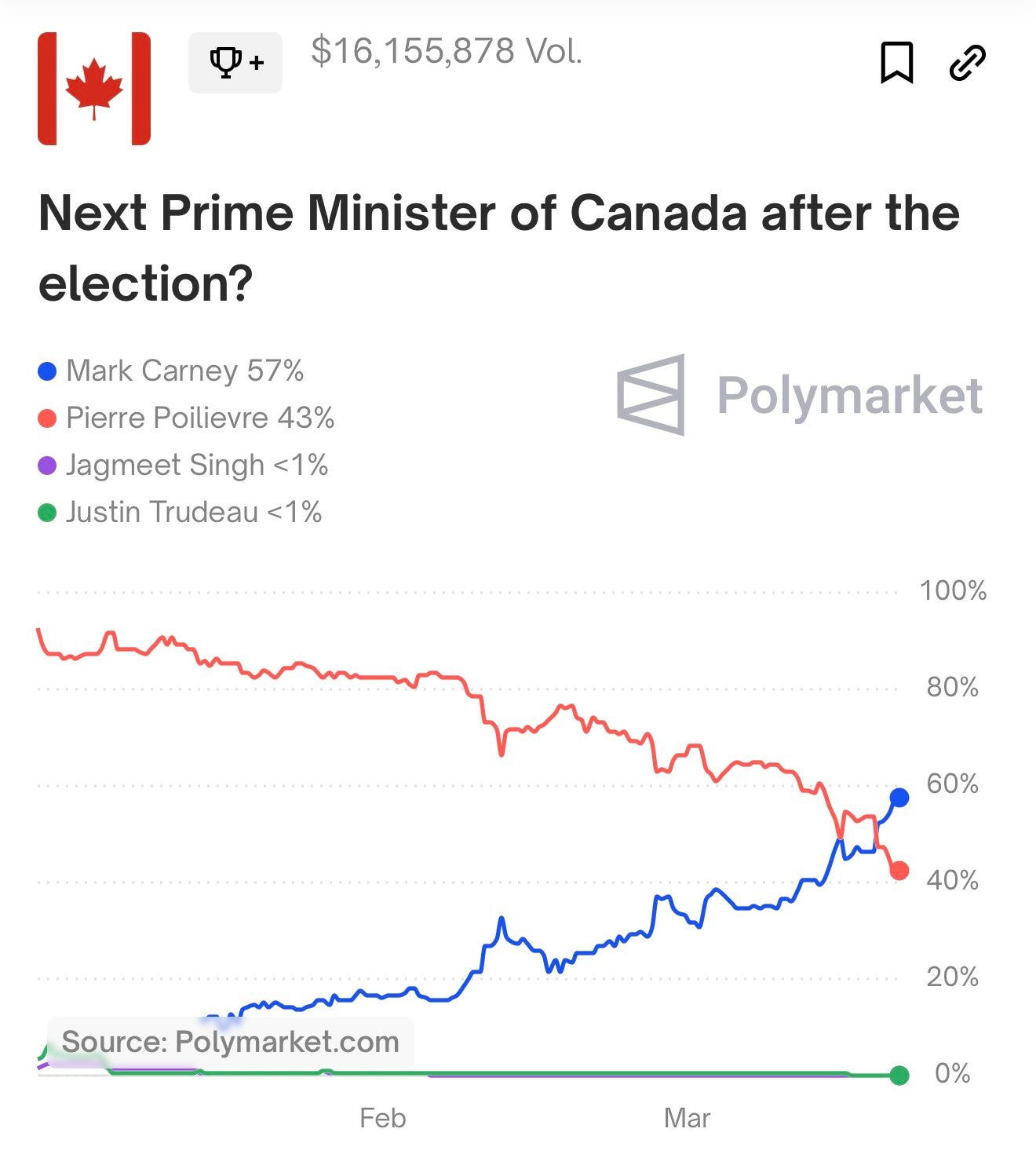I want to show you a chart. I think it is interesting.
It shows the polymarket odds for the next Canadian election.
A quick brief if you are not familiar with the polymarket.
The polymarket is an online betting game where people use real money to guess what will happen in the future. In the chart above, you can see that over $16 million in wagers have been placed to date. That number will increase as we get closer to the election.
On the Polymarket, instead of betting on sports, you can bet on real-world events, like who will win an election.
Here's how it works:
People buy "yes" or "no" shares for a specific event (like "Will Pierre Poilievre be Canada's next Prime Minister?").
The price of each share changes as more people bet—if lots of people think "yes," the price goes up, and if more think "no," the price goes down.
If you're right when the event happens, you win money based on the final price. If you're wrong, you lose your bet.
For elections, Polymarket acts like a real-time prediction tool, showing what people think will happen based on how much money they’re willing to risk. The prices often move with news, debates, or scandals, making it a fun way to track political races.
Traditional election polls ask people who they want to win. Polymarket shows who people think will win—because they are betting real money on it.
Polls can be wrong if people lie or change their minds. But on Polymarket, people try to be right because they don’t want to lose money. That’s why prediction markets like Polymarket have increasingly become more accurate than traditional polls.
However, in this case, the traditional polls agree with the polymarket odds.:
Leger Poll (March 14-16, 2025):
LPC: 42% (Mark Carney and the Liberals)
CPC: 39% (Pierre Poilievre and the Conservatives)
Ipsos Poll (March 17-19, 2025):
LPC: 42%
CPC: 36%
Angus Reid Institute Poll (March 17, 2025):
LPC: 42%
CPC: 37%
Let me ask you a question - but before I do, look at one more chart.
The next chart shows the real GDP per capita growth over the last ten years for all 38 of the OECD countries.
Remember all of you who argued when I showed that if Canada were to become the 51st state, it would be the third poorest state in the US?
I feel compelled to highlight - as I have many times, that Canada came through the Great Financial Crisis with a healthier balance sheet than any other G7 nation.
We have the potential - but elections matter. This is why I find the first chart so confounding…
Anyway… I told you that I had a question:
Imagine the real GDP chart above did not relate to countries but to company performance. Let's assume the chart is, therefore, tracking the return on invested capital for each company on the list - a good metric to weigh the general health and prospects of a company.
Note the the company at the bottom, highlighted in red (dead last).
Would you invest in that company?
Probably not.
Now, imagine that the company puts out a press release. They claim that they will be making a material change to the operation…
In the press release, they acknowledged that they had tried a bunch of different initiatives, and as the data shows, none of them worked. Unfortunately, they also stopped investing in their most profitable activities (whoops), getting completely wrapped up in narratives, popular opinions and virtue signalling.
Go woke - go broke, as they say.
But most importantly, they pointed out they’d had the same CEO and advisory board for the last ten years… And they were now firing the CEO to bring in fresh blood.
Great news!
But who will they choose to replace him?
Well, as it turns out, one of the CEO’s key strategic advisors over the last ten-year period…
An advisor who helped with many of the company’s failed ideas and supported reducing investment in the key profit centres.
Yikes.
Will that new CEO at least clean house and upgrade the management team?
Let’s see…
CFO? He is keeping her.
Head of International Development? Keeping him.
Head of internal trade? Keeping him, too.
In fact, every critical executive who has been in the boardroom over the previous ten years, overseeing the destruction of this company, will be retained.
The new CEO has already stated that his goal will be continuity.
Continuity… take another look at that GDP chart above.
In ten years, the company has fallen apart, and the new CEO is promising more of the same.
Let me ask you again: would you like to invest in this company?
The answer should seem obvious, but as we saw above, this presents quite a predicament for many folks.
Obviously, the “company” I am talking about is the ruling Canadian Liberal Party, and the ousted CEO is Mr. Trudeau. His replacement is one of his key economic advisors, Mark Carney, who has stated he will be retaining all key cabinet members:
Mélanie Joly - Minister of Foreign Affairs and International Development
Retained in her role
David McGuinty - Minister of Public Safety and Emergency Preparedness
Retained in his role
Dominic LeBlanc - Minister of International Trade and Intergovernmental Affairs
*Moved from Finance Minister (After Christia Freelands resignation) to Trade
François-Philippe Champagne - Minister of Finance
*Moved from Industry Minister to Finance
Chrystia Freeland - Minister of Transport and Internal Trade
*Moved from Finance Minister to Internal Trade
Ok, so what is the point?
If this were an investment decision, the decision would be obvious.
Divest. Cut your losses and walk away.
We just analyzed a business that used to be great, and still has the potential to be great, but has been hijacked by a board complicit in its destruction.
The weird part in this scenario is that the shareholders are voting for more of the same.
Honest question - let me know in the comments: What am I missing?
I recently gave a talk where I went deeper into some of these concerns and curiosities.
My team published it yesterday - you can watch it here:
That is all for today.
Have an epic Sunday,
Jay







In the US 75 million people voted for Kamala Harris. It appears to be a mental disease that infects a substantial portion of the human race, not just Canadians. The question is how bad does it have to get to see a change? It took Argentina about 90 years of socialism with terrible inflation before they finally "got it"
You are missing the fact that although Carney may have been Trudeau’s financial advisor, did Trudeau actually listen to him? Same with all the other ministers. Did Trudeau actually listen to their advice? Or were they forced to bend to Trudeau’s wishes when advancing their political agendas? You know that coming out with what “appears to be” a unified front is critically important when it comes to politics.
Obviously, the cabinet openly disagreed with Trudeau’s approach to the point of revolt.
Comparing business and government is not always a valid comparison. Look at what’s happening to the south where the head of government is running the country as if it’s a private business and he’s the CEO. Not working out too well so far, is it?